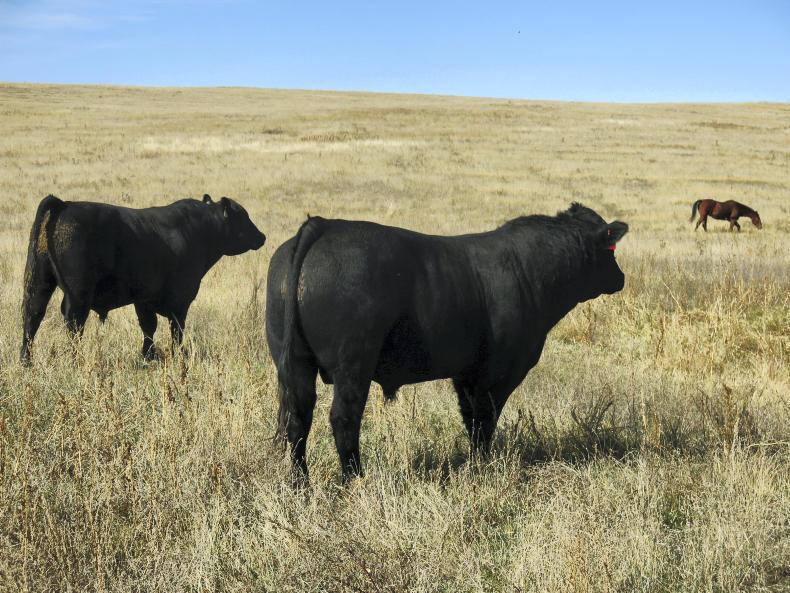Who represents the most important person in the beef production chain? The farmer? The processor? The retailer? All wrong; it is the consumer.
A satisfied consumer comes back for more – keeping things sustainable. The US beef grading system is built around this principle.
Eating experience
Marbling, or intramuscular fat, runs through the centre of lean muscle tissue. It is not to be confused with fat trim that’s chewy and unpleasant to eat. Instead, marbling is dissolvable fat that adds flavour to beef and leads to a melt-in-the-mouth texture. The photo below shows a well-marbled steak from an Angus heifer.

While it hasn’t significantly caught on in a health-conscious Europe, the American steak eater wants marbled meat so flavoursome that there isn’t a need to douse it in sauce. In fact, most authentic steakhouses serve their top cuts without any sauce.
Farmer rewards
While some finishers sell to processors on a liveweight basis, many sell carcase weight. Like in Ireland, they receive a base price – currently running at equivalent €3.55/kg. The carcase is then graded on two ribeye-based criteria and increments are added to, or taken away from, the base price per pound based on results.
Unlike in Ireland, where increments are fixed at 6c, American increments are dynamic and negotiable. While farmers are incentivised based on ‘Yield Grade’ (figure 1) which rewards terminal traits – an equivalent combination of our EUROP and fat class scales – they are also paid bonuses or penalised based on how marbled their beef is (Quality Grade).

Indeed, most steaks on retail shelves are labelled with their corresponding quality grades.
Given their propensity for fatness and marbling, purebred Angus or Angus crosses are the only show in town when it comes to producing prime cuts.
This is also the basis for our Angus bonus, though we don’t produce our cattle fat enough to feel the real benefits of marbling at eating time.
Read more
Watch: cross country cattle drive in South Dakota
Camera at the mart in Nebraska
Who represents the most important person in the beef production chain? The farmer? The processor? The retailer? All wrong; it is the consumer.
A satisfied consumer comes back for more – keeping things sustainable. The US beef grading system is built around this principle.
Eating experience
Marbling, or intramuscular fat, runs through the centre of lean muscle tissue. It is not to be confused with fat trim that’s chewy and unpleasant to eat. Instead, marbling is dissolvable fat that adds flavour to beef and leads to a melt-in-the-mouth texture. The photo below shows a well-marbled steak from an Angus heifer.

While it hasn’t significantly caught on in a health-conscious Europe, the American steak eater wants marbled meat so flavoursome that there isn’t a need to douse it in sauce. In fact, most authentic steakhouses serve their top cuts without any sauce.
Farmer rewards
While some finishers sell to processors on a liveweight basis, many sell carcase weight. Like in Ireland, they receive a base price – currently running at equivalent €3.55/kg. The carcase is then graded on two ribeye-based criteria and increments are added to, or taken away from, the base price per pound based on results.
Unlike in Ireland, where increments are fixed at 6c, American increments are dynamic and negotiable. While farmers are incentivised based on ‘Yield Grade’ (figure 1) which rewards terminal traits – an equivalent combination of our EUROP and fat class scales – they are also paid bonuses or penalised based on how marbled their beef is (Quality Grade).

Indeed, most steaks on retail shelves are labelled with their corresponding quality grades.
Given their propensity for fatness and marbling, purebred Angus or Angus crosses are the only show in town when it comes to producing prime cuts.
This is also the basis for our Angus bonus, though we don’t produce our cattle fat enough to feel the real benefits of marbling at eating time.
Read more
Watch: cross country cattle drive in South Dakota
Camera at the mart in Nebraska








 This is a subscriber-only article
This is a subscriber-only article







SHARING OPTIONS: